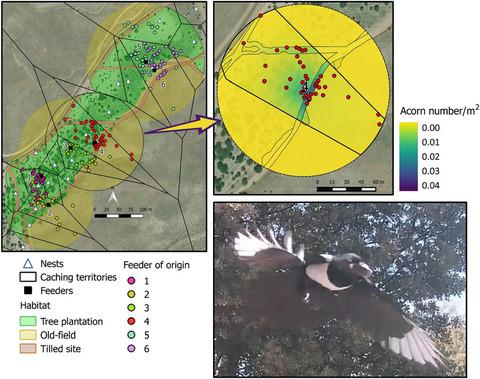Our official English website, www.x-mol.net, welcomes your
feedback! (Note: you will need to create a separate account there.)
Caching territoriality and site preferences by a scatter-hoarder drive the spatial pattern of seed dispersal and affect seedling emergence
Journal of Ecology ( IF 5.3 ) Pub Date : 2021-03-11 , DOI: 10.1111/1365-2745.13642 Loreto Martínez‐Baroja 1 , Lorenzo Pérez‐Camacho 1 , Pedro Villar‐Salvador 1 , Salvador Rebollo 1 , Alexandro B. Leverkus 1, 2 , Mario B. Pesendorfer 3 , Mercedes Molina‐Morales 4 , Jorge Castro 2 , José María Rey‐Benayas 1
中文翻译:

分散囤积者缓存领土和地点偏好驱动种子传播的空间格局并影响幼苗的出现
更新日期:2021-03-11
Journal of Ecology ( IF 5.3 ) Pub Date : 2021-03-11 , DOI: 10.1111/1365-2745.13642 Loreto Martínez‐Baroja 1 , Lorenzo Pérez‐Camacho 1 , Pedro Villar‐Salvador 1 , Salvador Rebollo 1 , Alexandro B. Leverkus 1, 2 , Mario B. Pesendorfer 3 , Mercedes Molina‐Morales 4 , Jorge Castro 2 , José María Rey‐Benayas 1
Affiliation

|
- For plants with seeds dispersed by scatter-hoarders, decision-making by animals when caching determines the spatial pattern of seed dispersal and lays the initial template for recruitment, driving the regeneration of many plant species. However, the mechanism by which animal behaviour shapes seed distributions in spatially complex landscapes is not well understood. We investigated caching territoriality and site preferences to determine the spatial pattern of seed caching at different scales and whether scatter-hoarding behaviour drives the spatial distribution of seedling emergence.
- We used radio-tracking and automatic wildlife cameras to monitor holm oak (Quercus ilex) acorn caching by Eurasian magpies (Pica pica), who are effective scatter-hoarders in agroforestry systems. We assessed the effect of caching territories, distance to seed source, habitat, sub-habitat, microsites and caching material in the spatial pattern of acorn dispersal by magpies. In addition, we analysed the relationship between the density of cached acorns and of emerged seedlings in different habitats.
- Breeding magpies cached the acorns inside their caching territories, where they preferred tilled areas over oak plantations and mostly avoided old fields. These differences in habitat preference were maximized at relatively short to medium dispersal distances, where most acorns were cached, and decreased or disappeared at long distances. Within tree plantations, magpies preferred high plant-productivity sites over low productivity ones. At the finest spatial scale, magpies preferred structures built by animals, such as rabbit grit mounds and latrines and ant litter mounds, to cache the acorns. In many sites, magpies selected uncommon materials such as stones and litter to cover caches. In the subsequent spring, seedling emergence was positively correlated with acorn cache density.
- Synthesis. Scatter-hoarding is a hierarchical process in which caching sites are selected using different criteria at different spatial scales driven by territoriality and site preferences. Territoriality constrained dispersal distance and the habitats available for acorn caching. Magpie territoriality therefore indirectly drives oak seedling emergence and can determine oak recruitment and forest regeneration.
中文翻译:

分散囤积者缓存领土和地点偏好驱动种子传播的空间格局并影响幼苗的出现
- 对于种子被分散囤积者分散的植物,缓存时动物的决策决定了种子传播的空间格局,并为招募奠定了初始模板,推动了许多植物物种的再生。然而,动物行为在空间复杂的景观中塑造种子分布的机制尚不清楚。我们调查了缓存地域性和站点偏好,以确定不同尺度种子缓存的空间模式,以及分散囤积行为是否驱动了幼苗出现的空间分布。
- 我们使用无线电跟踪和自动野生动物摄像机来监控欧亚喜鹊(Pica pica)对圣栎(Quercus ilex)橡子的缓存,它们是农林业系统中有效的分散囤积者。我们评估了缓存区域、到种子源的距离、栖息地、亚栖息地、微型站点和缓存材料在喜鹊传播橡子的空间模式中的影响。此外,我们还分析了不同栖息地的缓存橡子密度与出苗密度之间的关系。
- 繁殖喜鹊将橡子缓存在它们的缓存区域内,在那里它们更喜欢耕地而不是橡树种植园,并且大多避开旧田。栖息地偏好的这些差异在相对较短到中等的传播距离上最大化,其中大多数橡子被缓存,并在远距离减少或消失。在人工林中,喜鹊更喜欢植物生产力高的地点,而不是生产力低的地点。在最好的空间尺度上,喜鹊更喜欢由动物建造的结构,例如兔子砂砾堆和厕所以及蚂蚁窝,用来存放橡子。在许多地点,喜鹊选择不常见的材料(如石头和垃圾)来覆盖藏匿处。在随后的春天,出苗率与橡子贮藏密度呈正相关。
- 合成。Scatter-hoarding 是一个分层过程,在这个过程中,缓存站点是在不同的空间尺度上使用不同的标准选择的,这些标准由地域性和站点偏好驱动。领土限制了传播距离和可用于橡子缓存的栖息地。因此,喜鹊的领地性间接推动了橡树幼苗的出现,并可以决定橡树的补充和森林再生。











































 京公网安备 11010802027423号
京公网安备 11010802027423号